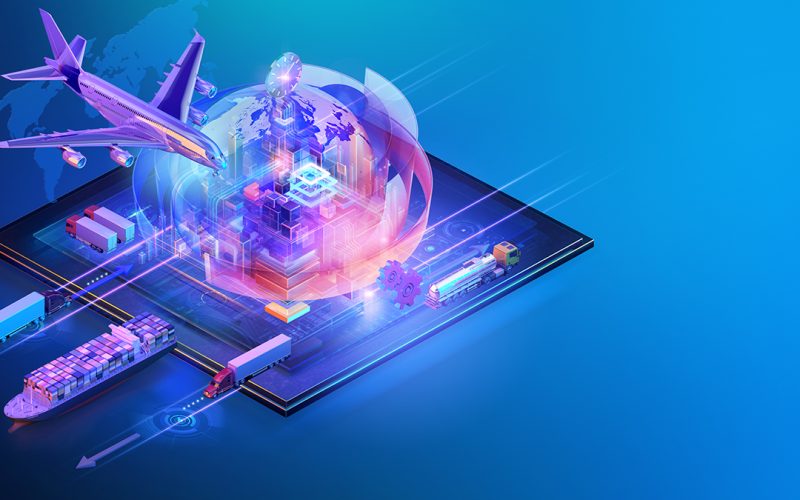The Evolution of Supply Chains in 2024: Trends, Challenges, and Innovations
The landscape of global supply chains is undergoing a major transformation. As we move further into 2024, businesses are adapting to an increasingly complex and interconnected world. From digitalization to sustainability, companies are embracing new technologies, practices, and strategies to stay competitive in a rapidly changing market. This article explores the latest trends in supply chains, examines the challenges businesses face, and provides real-world examples and case studies of companies leading the way.
Introduction to Modern Supply Chains

A supply chain refers to the network of organizations, resources, activities, and technology involved in the creation and distribution of goods and services. Traditionally, supply chains operated with a focus on cost efficiency and timely delivery, but today’s environment requires businesses to consider factors like sustainability, resilience, and technology integration.
In 2024, supply chains are evolving faster than ever due to several factors:
- Technological advancements like artificial intelligence (AI) and machine learning.
- Increasing consumer demand for eco-friendly and sustainable practices.
- Global disruptions, from the COVID-19 pandemic to geopolitical conflicts, which have highlighted the need for more resilient operations.
The challenge now is for businesses to stay agile and adapt to these changes while ensuring efficiency, cost-effectiveness, and customer satisfaction.
The Digital Transformation of Supply Chains
One of the most significant changes in supply chain management in recent years has been the digital transformation. Companies are increasingly relying on technology to streamline operations, improve decision-making, and enhance customer experiences. Technologies like AI, machine learning, robotics, and IoT (Internet of Things) are playing a central role.
AI and Machine Learning for Predictive Analytics
Artificial intelligence and machine learning are at the forefront of supply chain innovations. By analyzing vast amounts of data from past transactions, customer behaviors, and supply chain operations, AI-powered systems can predict demand, detect patterns, and provide actionable insights.
For example, Amazon uses AI and machine learning to forecast demand for products across its global network. By doing so, it can predict regional demand fluctuations, adjust inventory levels, and optimize delivery routes, ensuring minimal stockouts and reducing excess inventory.
Automation in Warehouses
Another key aspect of digital transformation is the rise of automation. In warehouses, robots are replacing human labor for tasks like picking, packing, and sorting. This not only speeds up the process but also reduces human error and labor costs. Ocado, a UK-based grocery retailer, has implemented automated warehouses where robots handle most of the tasks, resulting in increased efficiency and reduced operational costs.
Sustainability and Green Supply Chains
Sustainability has become a critical focus in modern supply chains. As consumers become more environmentally conscious, businesses are responding by adopting green supply chain practices to reduce their environmental impact. In 2024, businesses are exploring innovative ways to improve sustainability without compromising on efficiency.
Circular Economy and Recycling
A circular economy focuses on keeping products, materials, and resources in use for as long as possible, minimizing waste. Companies like Patagonia are incorporating this philosophy into their supply chains by using recycled materials for their clothing and offering customers the ability to return old garments for reuse or recycling.
For instance, Interface, a global carpet manufacturer, uses recycled nylon from discarded fishing nets to produce its products, thus reducing both waste and the need for raw materials. Their efforts in sustainable manufacturing not only help the environment but also enhance brand loyalty, as consumers are more likely to support eco-conscious brands.
Green Logistics and Packaging
The logistics sector has also embraced sustainability through eco-friendly packaging and transportation methods. Companies are opting for biodegradable materials or minimalist packaging to reduce waste. Additionally, businesses are investing in electric vehicles (EVs) for last-mile delivery, reducing carbon emissions in urban areas.
For example, UPS has invested heavily in EVs and alternative fuel vehicles to reduce the carbon footprint of its delivery operations. This move not only aligns with global environmental goals but also offers cost savings in the long run.
Building Resilience in Global Supply Chains
The COVID-19 pandemic highlighted the vulnerabilities in global supply chains. Sudden disruptions caused by lockdowns, labor shortages, and transportation delays exposed the fragility of traditional supply chain models. As a result, companies are now prioritizing resilience and flexibility in their supply chain strategies.
Diversification of Suppliers
In 2024, businesses are focusing on diversifying their supplier networks to minimize the risk of over-dependence on a single region or supplier. This approach, known as multi-sourcing, helps mitigate disruptions and ensures continuity in the supply of raw materials and goods.
For example, Apple has diversified its manufacturing partners beyond China to countries like India and Vietnam. This strategy enables Apple to maintain production levels even if one country faces a supply chain disruption.
Nearshoring and Onshoring Trends
Another strategy gaining traction is nearshoring or onshoring, which involves relocating production closer to home markets. This approach helps companies reduce transportation costs, shorten lead times, and lessen dependence on overseas suppliers.
Ford is an example of a company that has embraced nearshoring. The automotive giant moved production of certain parts from overseas to the U.S. to reduce reliance on suppliers in Asia, enhancing supply chain resilience.
Blockchain Technology in Supply Chain Transparency

Blockchain is emerging as a powerful tool to improve transparency and traceability in supply chains. With blockchain, every transaction and movement of goods can be recorded on a decentralized ledger, providing a transparent and tamper-proof record of goods from origin to destination.
Improved Traceability
Blockchain enables end-to-end traceability, allowing businesses and consumers to track the origin and journey of products. In the food industry, for example, Walmart has implemented blockchain to track the origin of produce, ensuring food safety and reducing the time it takes to trace contaminated products.
Enhancing Security and Reducing Fraud
Blockchain can also reduce fraud by ensuring that all transactions are securely recorded and verified. The diamond industry is using blockchain to verify the authenticity of diamonds and prevent the circulation of conflict diamonds.
Leveraging AI for Demand Forecasting and Inventory Management
As supply chains become more complex, demand forecasting and inventory management are critical for optimizing operations. AI and machine learning algorithms help businesses make data-driven decisions about how much stock to hold, when to reorder, and where to allocate resources.
Improved Forecasting Accuracy
Using AI, companies can predict demand with much higher accuracy than traditional methods. For example, Walmart uses AI-powered systems to forecast the demand for thousands of products across its stores, reducing stockouts and ensuring shelves are always stocked with the right items.
Optimizing Inventory Levels
AI also helps businesses optimize their inventory levels, ensuring that they maintain the right balance between supply and demand. This reduces the risks of overstocking, which can tie up valuable capital, and understocking, which can lead to missed sales.
The E-commerce Boom and Last-Mile Delivery Challenges
The rise of e-commerce, especially accelerated by the COVID-19 pandemic, has placed greater pressure on supply chains. One of the biggest challenges in the e-commerce supply chain is last-mile delivery, which involves getting products from local distribution centers to the customer’s doorstep.
Challenges in Last-Mile Delivery
E-commerce giants like Amazon are facing growing challenges in managing last-mile delivery efficiently. The complexity of urban areas, traffic congestion, and consumer expectations for faster delivery are making this part of the supply chain increasingly costly.
Innovative Solutions: Drones and Autonomous Vehicles
To overcome these challenges, companies are exploring innovative solutions such as drones and autonomous vehicles. Amazon has already started testing Prime Air drones, aiming to deliver packages to customers within 30 minutes. Similarly, Waymo, a subsidiary of Google, is testing autonomous vehicles for last-mile delivery.
Cybersecurity in Supply Chains
As supply chains become more digitized, they are also becoming more vulnerable to cyber threats. Cybersecurity is now a top priority for businesses looking to protect sensitive data and ensure the smooth functioning of their operations.
Risks and Threats
Hackers can target vulnerable supply chain partners, gaining access to financial data, intellectual property, and confidential information. Cyber-attacks can cause delays, financial losses, and reputational damage.
Best Practices for Cybersecurity
To protect their operations, companies are implementing stronger security measures, such as multi-factor authentication, data encryption, and regular security audits. Microsoft, for example, has implemented a comprehensive cybersecurity strategy to safeguard its global supply chain from potential threats.
The Role of 3D Printing in Supply Chain Innovation

3D printing, also known as additive manufacturing, is revolutionizing the supply chain by enabling businesses to produce products on-demand, closer to the point of need. This eliminates the need for large inventories and long lead times.
Localized Production and Customization
With 3D printing, businesses can produce goods locally, reducing transportation costs and minimizing the environmental impact. Industries such as healthcare and automotive are already using 3D printing for producing customized products, such as prosthetics and car parts.
Case Study: General Electric
General Electric (GE) is a pioneer in adopting 3D printing for manufacturing aircraft components. By using 3D printing, GE reduced the weight of certain parts, improving fuel efficiency and lowering production costs.
Overcoming Supply Chain Disruptions: Key Challenges and Solutions
Despite the technological advancements, supply chains continue to face disruptions, whether caused by natural disasters, political instability, or unforeseen global events. Businesses must be prepared to navigate these challenges and ensure that their operations remain resilient.
Multi-Sourcing and Diversification
One of the most effective strategies for managing disruptions is multi-sourcing, which ensures that businesses have backup suppliers in place. Nike, for example, relies on a diverse network of suppliers to minimize risks from disruptions in any one region.
Flexibility and Contingency Planning
Companies are also focusing on improving their contingency planning. By creating flexible supply chain models, businesses can adapt quickly to changes in demand, supply availability, or external conditions.
Conclusion
The future of supply chains is shaped by technology, sustainability, and resilience. In 2024, companies are leveraging digital tools, sustainable practices, and innovative strategies to optimize their operations and meet changing consumer expectations. As challenges like cybersecurity threats and last-mile delivery persist, businesses must remain agile and prepared for the next wave of disruptions. The companies that embrace these changes will be well-positioned to lead in the global marketplace.










